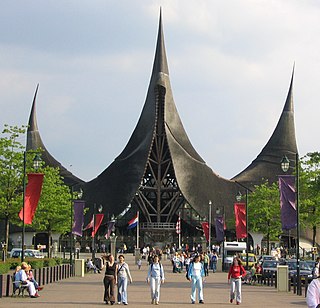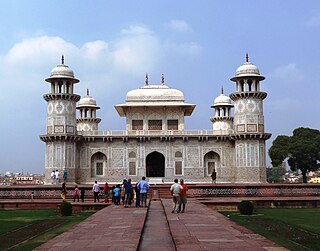
Ton van de Ven was a Dutch industrial designer. He is best known as the creative director at the Efteling theme park.
The Stoomcarrousel is an attraction of the Efteling amusement park in the Netherlands. It is an indoor carousel situated in what is now known as the "Carousel Palace" (in Dutch "Carrouselpaleis"; formerly "De Efteling Stoomcarrousel" and originally "Janvier's Stoomcaroussel".

The Diorama is a miniature world in Efteling amusement park in the Netherlands. The highly detailed mountainous world, or Diorama, was designed by Anton Pieck and opened in 1971, in honour of the 20th birthday of Efteling.

Droomvlucht is a dark ride in Efteling amusement park in the Netherlands. It was designed by Ton van de Ven, built by Translift and opened in 1993.

Villa Volta is an attraction in the amusement park Efteling in the Netherlands. It is a rare type of ride known as a Madhouse, which is a sort of haunted house, where the visitors get the illusion that either the building, the visitors themselves or both are turned upside down. It has been designed by Ton van de Ven and was built by Vekoma in 1996. At the time it was the first of its sort; nowadays the concept has been taken over by a number of other amusement parks.
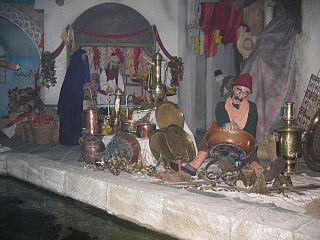
Fata Morgana, the forbidden city, also known as 1001 Arabian Nights is a dark ride in amusement park Efteling in the Netherlands. It was designed by Ton van de Ven and Jan Verhoeven and opened in 1986.

Carnival Festival is a dark ride in amusement park Efteling in the Netherlands. It was designed by Joop Geesink and opened its doors in 1984.

Piraña is a river rapids ride in amusement park Efteling in the Netherlands. It was designed by Ton van de Ven, built by Intamin, and opened in 1983.
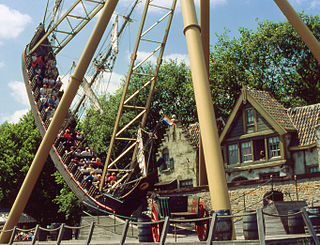
Halve Maen is a Pirate Ship ride at Efteling theme park in the Netherlands. Designed by Ton van de Ven and manufactured by Intamin, it opened its doors in 1982.
Theater de Efteling is a theatre in the amusement park Efteling in the Netherlands. It was designed by Ton van de Ven and opened its doors in 2002.
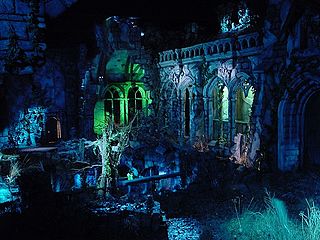
The Haunted Castle is a haunted attraction in the amusement park Efteling in the Netherlands. It was designed by Ton van de Ven and was the first attraction built outside the Fairy Tale Forest.

Kaatsheuvel is a village in the Dutch province of North Brabant, situated along highways N261 and N628. With a population of roughly 16,600, it is the largest village in and the capital of the municipality of Loon op Zand, which also consists of the villages of De Moer and Loon op Zand. As Kaatsheuvel is a municipality capital, it had a town hall located in the town centre. The town hall was torn down in 2010 as part of an ambitious plan to build a lively new town centre. Currently the new town centre is being built, working title Bruisend Dorpshart. Kaatsheuvel is (internationally) well known for the Efteling theme park and a gateway to National Park Loonse en Drunense Duinen.
Gondoletta is a Water ride in amusement park Efteling in the Netherlands. It was developed by Intamin ; designed by Ton van de Ven and started operating in 1981.

Tin Lizzies is a car ride in amusement park Efteling in the Netherlands. Designed by Joop Geesink and built by Mack Rides it started operating in 1984.

Sadków is a village in the administrative district of Gmina Kąty Wrocławskie, within Wrocław County, Lower Silesian Voivodeship, in south-western Poland. Prior to 1945 it was in Germany. It lies approximately 5 kilometres (3 mi) north-east of Kąty Wrocławskie and 17 km (11 mi) south-west of the regional capital Wrocław.
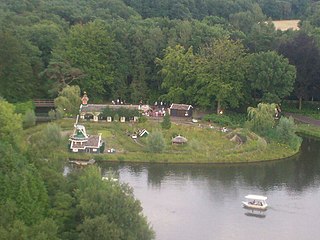
The Children’s Railway is a pedal train attraction in the Efteling amusement park.
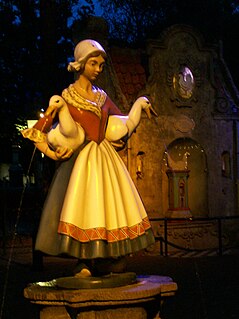
The Anton Pieck Square is a square in the Efteling, a theme park in the Netherlands.

Baron 1898 is a steel Dive Coaster at the Efteling theme park. The first test ride was held on 8 May 2015, after construction of the track was completed, and the first manned operation was conducted on June 18, 2015. Music was created by the Brussels Philharmonie symphony orchestra and several producers, under the direction of René Merkelbach. The ride opened on July 1, 2015. It is the first dive coaster manufactured by B&M that doesn't feature a turn between the lift hill and the first drop.
Bursa Merinos Energy Museum is a technology museum dedicated to electricity, which was established in 2012 in the defunct power plant of an abandoned textile factory in Bursa, northwestern Turkey.


